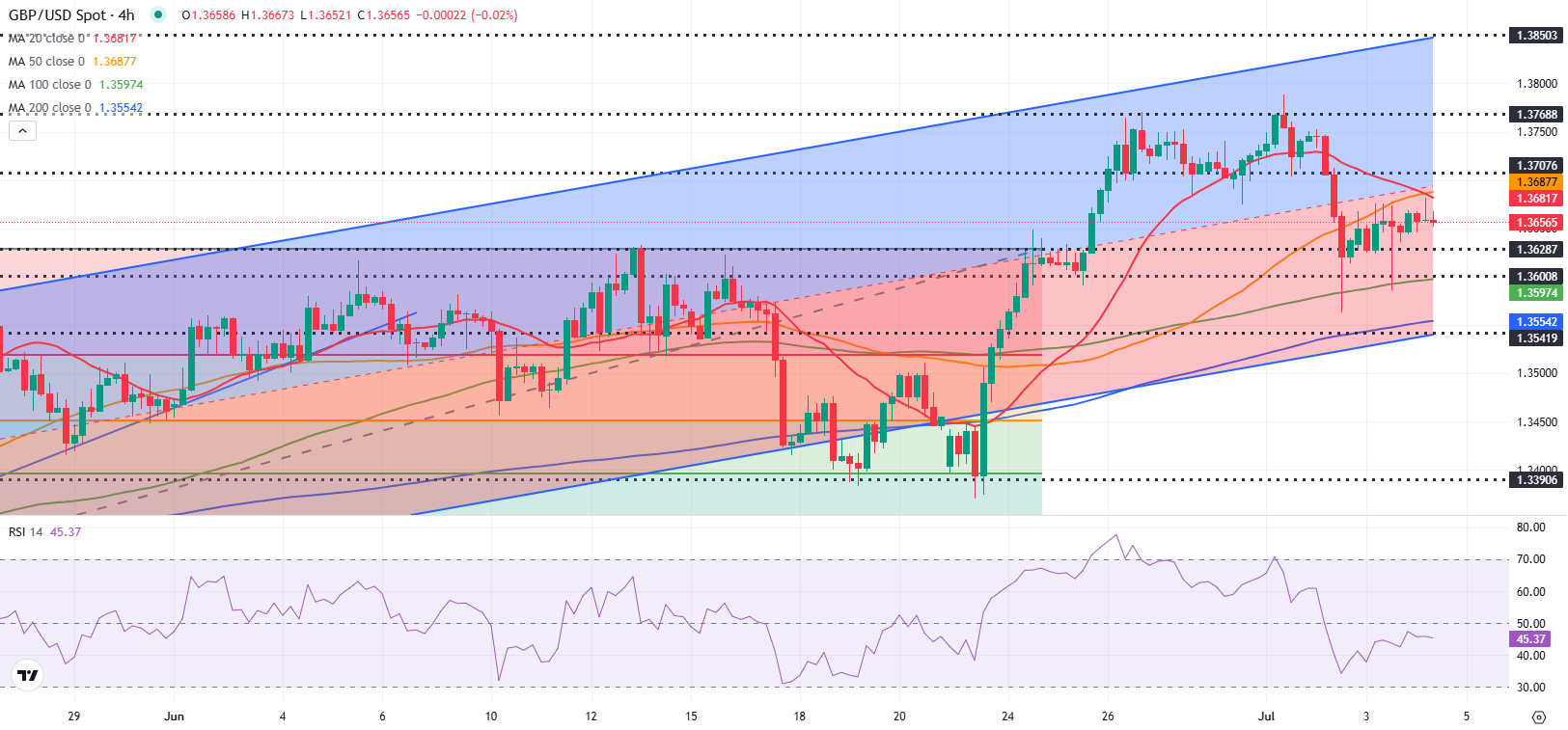- GBP/USD moves sideways at around 1.3650 on Friday.
- The cautious market stance makes it difficult for the pair to gain traction.
- Trading volumes are likely to thin out, with US financial markets remaining closed on July 4.
Following the sharp decline seen on Wednesday, GBP/USD found support on Thursday and closed the day marginally higher. The pair, however, struggles to extend its rebound and trades in a narrow band at around 1.3650 in the European session on Friday.
British Pound PRICE This week
The table below shows the percentage change of British Pound (GBP) against listed major currencies this week. British Pound was the weakest against the Canadian Dollar.
| USD | EUR | GBP | JPY | CAD | AUD | NZD | CHF | |
|---|---|---|---|---|---|---|---|---|
| USD | -0.41% | 0.39% | -0.01% | -0.76% | -0.34% | -0.20% | -0.67% | |
| EUR | 0.41% | 0.77% | 0.43% | -0.36% | 0.05% | 0.22% | -0.26% | |
| GBP | -0.39% | -0.77% | -0.55% | -1.10% | -0.71% | -0.58% | -1.03% | |
| JPY | 0.01% | -0.43% | 0.55% | -0.75% | -0.27% | -0.15% | -0.61% | |
| CAD | 0.76% | 0.36% | 1.10% | 0.75% | 0.38% | 0.56% | 0.09% | |
| AUD | 0.34% | -0.05% | 0.71% | 0.27% | -0.38% | 0.15% | -0.32% | |
| NZD | 0.20% | -0.22% | 0.58% | 0.15% | -0.56% | -0.15% | -0.47% | |
| CHF | 0.67% | 0.26% | 1.03% | 0.61% | -0.09% | 0.32% | 0.47% |
The heat map shows percentage changes of major currencies against each other. The base currency is picked from the left column, while the quote currency is picked from the top row. For example, if you pick the British Pound from the left column and move along the horizontal line to the US Dollar, the percentage change displayed in the box will represent GBP (base)/USD (quote).
Easing geopolitical concerns in the UK helped Pound Sterling hold its ground early Thursday after British Prime Minister Keir Starmer reassured that finance minister Rachel Reeves will remain in her position.
Later in the day, the US Dollar (USD) gathered strength on upbeat macroeconomic data releases and capped GBP/USD’s upside. The US Bureau of Labor Statistics reported that Nonfarm Payrolls (NFP) rose by 147,000 in June. This reading came in better than the market expectation of 110,000. Furthermore, the Unemployment Rate edged lower to 4.1% from 4.2% in May. Finally, the Institute for Supply Management’s (ISM) Services Purchasing Managers’ Index (PMI) rose to 50.8 in June from 49.9, showing that the business activity in the service sector expanded following May’s contraction.
Early Friday, the UK’s FTSE 100 Index loses about 0.4% on the day, reflecting a cautious market mood. In a report published on Friday, S&P Global said that the UK’s inability to make modest cuts to welfare spending underscores the government’s very limited budgetary room for maneuver.
Financial markets in the US will remain closed in observance of the July 5 holiday on Friday. Hence, GBP/USD could continue to move sideways heading into the weekend.
GBP/USD Technical Analysis

GBP/USD remains below the 20-period and the 50-period Simple Moving Averages (SMA) on the 4-hour chart and the Relative Strength Index (RSI) indicator stays below 50, pointing to a lack of buyer interest.
On the downside, 1.3630 (static level) aligns as an intermediate support level before 1.3600 (100-period SMA) and 1.3555 (200-period SMA). Looking north, resistance levels could be seen at 1.3680 (20-period SMA, 50-period SMA, mid-point of the ascending channel),1.3710 (static level) and 1.3770 (static level).
Pound Sterling FAQs
The Pound Sterling (GBP) is the oldest currency in the world (886 AD) and the official currency of the United Kingdom. It is the fourth most traded unit for foreign exchange (FX) in the world, accounting for 12% of all transactions, averaging $630 billion a day, according to 2022 data.
Its key trading pairs are GBP/USD, also known as ‘Cable’, which accounts for 11% of FX, GBP/JPY, or the ‘Dragon’ as it is known by traders (3%), and EUR/GBP (2%). The Pound Sterling is issued by the Bank of England (BoE).
The single most important factor influencing the value of the Pound Sterling is monetary policy decided by the Bank of England. The BoE bases its decisions on whether it has achieved its primary goal of “price stability” – a steady inflation rate of around 2%. Its primary tool for achieving this is the adjustment of interest rates.
When inflation is too high, the BoE will try to rein it in by raising interest rates, making it more expensive for people and businesses to access credit. This is generally positive for GBP, as higher interest rates make the UK a more attractive place for global investors to park their money.
When inflation falls too low it is a sign economic growth is slowing. In this scenario, the BoE will consider lowering interest rates to cheapen credit so businesses will borrow more to invest in growth-generating projects.
Data releases gauge the health of the economy and can impact the value of the Pound Sterling. Indicators such as GDP, Manufacturing and Services PMIs, and employment can all influence the direction of the GBP.
A strong economy is good for Sterling. Not only does it attract more foreign investment but it may encourage the BoE to put up interest rates, which will directly strengthen GBP. Otherwise, if economic data is weak, the Pound Sterling is likely to fall.
Another significant data release for the Pound Sterling is the Trade Balance. This indicator measures the difference between what a country earns from its exports and what it spends on imports over a given period.
If a country produces highly sought-after exports, its currency will benefit purely from the extra demand created from foreign buyers seeking to purchase these goods. Therefore, a positive net Trade Balance strengthens a currency and vice versa for a negative balance.

